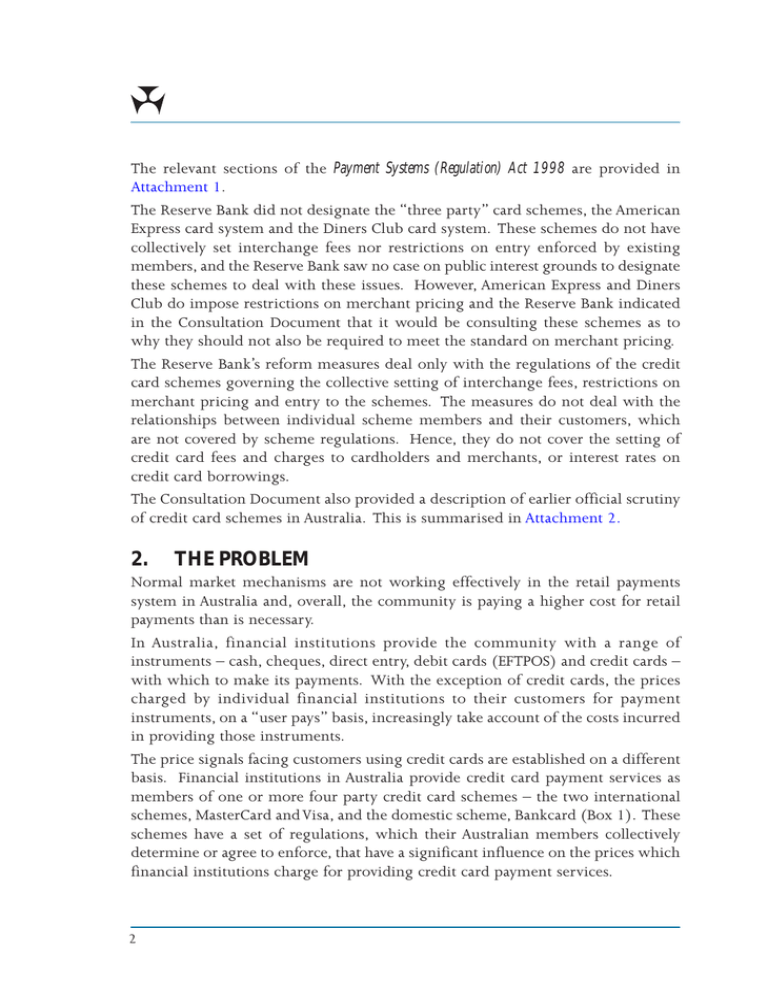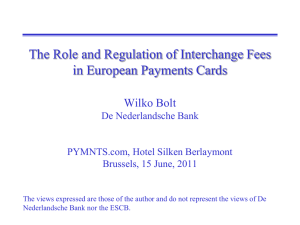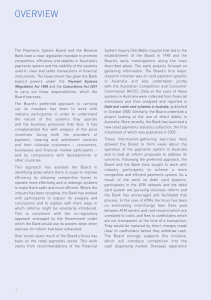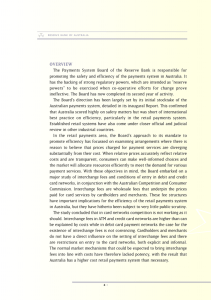Payment Systems (Regulation) Act 1998 . Attachment 1
advertisement

The relevant sections of the Payment Systems (Regulation) Act 1998 are provided in Attachment 1. The Reserve Bank did not designate the “three party” card schemes, the American Express card system and the Diners Club card system. These schemes do not have collectively set interchange fees nor restrictions on entry enforced by existing members, and the Reserve Bank saw no case on public interest grounds to designate these schemes to deal with these issues. However, American Express and Diners Club do impose restrictions on merchant pricing and the Reserve Bank indicated in the Consultation Document that it would be consulting these schemes as to why they should not also be required to meet the standard on merchant pricing. The Reserve Bank’s reform measures deal only with the regulations of the credit card schemes governing the collective setting of interchange fees, restrictions on merchant pricing and entry to the schemes. The measures do not deal with the relationships between individual scheme members and their customers, which are not covered by scheme regulations. Hence, they do not cover the setting of credit card fees and charges to cardholders and merchants, or interest rates on credit card borrowings. The Consultation Document also provided a description of earlier official scrutiny of credit card schemes in Australia. This is summarised in Attachment 2. 2. THE PROBLEM Normal market mechanisms are not working effectively in the retail payments system in Australia and, overall, the community is paying a higher cost for retail payments than is necessary. In Australia, financial institutions provide the community with a range of instruments – cash, cheques, direct entry, debit cards (EFTPOS) and credit cards – with which to make its payments. With the exception of credit cards, the prices charged by individual financial institutions to their customers for payment instruments, on a “user pays” basis, increasingly take account of the costs incurred in providing those instruments. The price signals facing customers using credit cards are established on a different basis. Financial institutions in Australia provide credit card payment services as members of one or more four party credit card schemes – the two international schemes, MasterCard and Visa, and the domestic scheme, Bankcard (Box 1). These schemes have a set of regulations, which their Australian members collectively determine or agree to enforce, that have a significant influence on the prices which financial institutions charge for providing credit card payment services. 2 Box 1: Four party credit card schemes The Bankcard, MasterCard and Visa credit card schemes are known as “four party” card schemes because up to four parties are typically involved in the payment process. These parties are: • the cardholder; • the issuer, the financial institution that issues the credit card to its customers; • the acquirer, the financial institution that serves the merchant accepting the credit card for payment; and • the merchant. The flow of fees (and interest payments) in a four party scheme is shown below. Interchange fee Issuer Card fees (and interest payments) Cardholder Acquirer Merchant service fee Merchant Price incentives in credit card schemes The price signals facing consumers choosing between different payment instruments do not promote efficient resource use in Australia’s retail payments system. The typical price incentives for a consumer to use a debit card (EFTPOS) or credit card, compared to the costs which financial institutions incur in providing these instruments (from information provided to the Joint Study), are shown in Table 1. In many circumstances, a debit card is a close substitute for a credit card, particularly for cardholders who do not have a cash constraint. Consumers using a debit card typically face a transaction fee of around $0.50 per transaction (beyond a fee-free threshold) for accessing their own funds; this fee is broadly in line with the average cost of providing debit card services ($0.41). Credit cardholders who settle their account in full each month (known as “transactors”) pay no transaction 3 Table 1: Debit and credit card costs* $ per $100 transaction Debit card Credit card Total cost (issuer plus acquirer) Costs passed to cardholder 0.41 2.01 0.50a -0.42 to -1.04b a b * For transactions beyond the fee-free threshold. Includes costs of interest-free period, as defined in the Joint Study (p78), and loyalty points. The table excludes annual fees for credit cards and monthly account-keeping fees for deposit accounts. These are fixed costs and not relevant to the decision about which card to use for an individual transaction. Source: Reserve Bank of Australia and Australian Competition and Consumer Commission (2000) and Reserve Bank of Australia Bulletin, July 2001. fee, and may be paid in the form of loyalty points, for using the funds of their financial institution. In these cases, the benefits from using a credit card can be as much as $1.04 for an average size transaction of around $100, compared to the average cost of $2.01 to provide this transaction (excluding the cost of the revolving credit facility). In response to these price incentives, credit card usage in Australia continues to grow strongly (Figure 1). This has occurred despite the fact that, for the community, credit cards are one of the most expensive payment instruments provided by financial institutions in terms of the resource costs involved. Merchant service fees on credit cards average 1.8 per cent of the value of each credit card transaction and can be up to four per cent for smaller merchants (Table 2). Survey data from the Australian Retailers Association show that, taking into account the average value of transactions for each payment instrument, credit card transactions in Australia cost merchants over twice as much as cash and substantially more than debit cards (Figure 2). US data show similar relative costs. Financial institutions promote the credit card most actively because it is the payment instrument for which they receive the highest return. At the same time, it is one of the most costly instruments for financial institutions to provide and one of the most expensive for merchants to accept. Price incentives are therefore encouraging the use of a relatively high-cost payment instrument over lower cost alternatives. 4 Figure 1: Number of debit and credit card payments per capita per year No. (e) 40 No. 40 (e) 30 30 Debit 20 20 Credit 10 0 10 1990 1992 1994 1996 1998 2000 2002 0 (e) estimate Source: Reserve Bank of Australia Bulletin and ABS Catalogue No. 3101.0. This structure of price incentives is not the result of normal competitive processes. It is a consequence of the regulatory framework established by the credit card schemes. It is a consequence, as well, of the fact that the same group of banks and other deposit-taking institutions set the fee structures for credit cards and the other main payment instruments in Australia. Regulations of the credit card schemes The four party credit card schemes in Australia have regulations that have the effect of suppressing or distorting the normal market mechanisms. First, each scheme in Australia has interchange fees which are set collectively by members that are otherwise competitors in providing credit card payment services to cardholders and merchants. The interchange fee is the fee paid to the financial institution which issues the card (the “issuer”) by the financial institution which provides services to the merchant (the “acquirer”) whenever the merchant accepts credit cards for payment. Acquirers pass on interchange fees to their merchants through the merchant service fee, which also includes a margin to cover the costs 5 Table 2: Merchant service fees on credit cards per cent, 2000 Annual turnover ($m) 0.10 0.25 0.50 1.00 2.50 5.00 10.00 25.00 50.00 100.00 500.00 Average 2.53 2.30 2.10 1.75 1.68 1.53 1.51 1.47 1.38 1.35 1.30 Minimum 1.36 1.25 0.90 1.00 1.00 1.19 0.90 1.00 1.25 1.25 1.00 Maximum 4.00 4.00 4.00 4.00 3.00 3.25 3.00 3.00 1.50 3.00 3.00 Source: Australian Retailers Association (2001a). of providing acquiring services. Interchange fees are a type of transfer payment that enables credit card issuers to recover some of their costs from acquirers and, in turn, from merchants. Information provided to the Joint Study by card scheme members showed that the average interchange fee received by issuers in Australia was around 0.95 per cent of the value of each credit card transaction. Secondly, MasterCard and Visa (but not Bankcard) impose restrictions on merchant pricing (so-called “no surcharge” rules) that deny merchants the freedom to set their own prices. Merchants are not free to pass on the merchant service fee to the users of credit cards. Instead, merchants face an “all or nothing” choice in accepting credit cards and have no alternative but to pass their credit card costs onto all customers, regardless of whether they are credit card users, through the prices of goods and services. Restrictions on merchant pricing constrain the ability of merchants to negotiate with the providers of credit card payment services and ensure that credit cardholders do not face the costs of the payment instruments they are choosing. Thirdly, each scheme in Australia imposes minimum entry standards that are intended to ensure the safety of the scheme, but have the effect of unduly limiting 6 Figure 2: Payment costs to Australian retailers* percentage of average transaction value % % 3.0 3.0 2.5 2.5 2.0 2.0 1.5 1.5 1.0 1.0 0.5 0.5 0.0 0.0 Charge card Bank credit card Cheque Cash Debit card * Debit card costs include any rebates that large retailers may receive, and hence understate the processing costs to retailers of a debit card transaction. According to information from the Australian Retailers Association, the processing cost of debit cards for the sample of merchants in Figure 2, abstracting from any rebate, is around 0.4 per cent of the average transaction value. Source: Australian Retailers Association (2001b). competition. Generally speaking, only authorised deposit-taking institutions supervised by the Australian Prudential Regulation Authority (APRA) are eligible for participation; in Australia, participants in each scheme are all members of that scheme. Supervision by APRA is a broad-brush requirement that does not directly address the particular risks generated to the schemes by credit card issuers and acquirers. Two of the schemes prohibit their members from acting only as acquirers and two schemes have penalties for members whose business is weighted heavily towards acquiring rather than issuing. Such restrictions and penalties discourage the participation of specialist credit card acquirers which could promote competition in the acquiring market and strengthen the representation of acquiring 7 interests in the process of setting interchange fees. The credit card market in Australia remains a highly concentrated one: the four major banks account for 90 per cent of all credit card transactions acquired by banks and 89 per cent of transactions on cards issued by banks. Credit card interchange fees play a pivotal role in determining the incentives for consumers to use, and merchants to accept, credit cards. Revenues from interchange fees allow credit card issuers effectively to “subsidise” cardholders to use their credit cards, in the sense that they are charged less than the cost of the credit card payment services they use (or are even offered rebates in the form of loyalty points). The burden of this subsidy falls initially on merchants, but ultimately on the community as a whole. In Australia, credit card interchange fees are not determined by a competitive market. While it is possible that a collective process may lead to interchange fees being set at an efficient level, the conditions under which this is likely to occur in practice – strong competition between credit card schemes, strong competition between credit cards and other payment instruments, and a balance of issuing and acquiring interests in the fee-setting process – do not prevail in Australia. Interchange fees have been set without any external scrutiny or accountability to the community. Interchange fees have been rigid – until late last year, rates did not change in 27 years in the Bankcard scheme and rates have changed only once in the past decade in the MasterCard and Visa schemes – and the fee-setting process has lacked transparency and any objective benchmarks against which interchange fees might be assessed. The “checks and balances” that might be expected to influence interchange fees under robust competition in the payments system have not operated in Australia. Overlapping governance arrangements mean that the four major banks dominate the credit card schemes in Australia and are also the main providers of competing payment instruments; because there are no other large credit card acquirers, merchants have not had a strong and independent voice in interchange fee setting. This environment provides no assurance that the current level of interchange fees ultimately passed onto the community is in its interest. Where the competitive environment is not robust, the risk is that collectively set interchange fees can be above an efficient level, allowing issuers to increase their subsidy to credit cardholders and resulting in price signals that encourage the use of credit cards relative to alternative payment instruments. 8 Summary In summary, the pricing of credit card payment services is sending consumers a misleading signal about the cost to the community of different payment instruments, while barriers to entry are shielding the members of the credit card schemes from the competitive pressures that non-financial corporations of substance could bring to bear. The consequence of the current structure of price incentives is that consumers using credit cards are not necessarily those who ultimately bear the costs. The community bears a significant proportion of credit card costs: because merchants have no alternative but to pass merchant service fees into the general level of prices, the costs are borne by all consumers, whether they use a credit card or not. A much larger proportion of credit card costs are borne directly by credit cardholders using the “revolving” line of credit, who pay interest rates significantly above rates on other forms of unsecured lending. Credit card transactors contribute little directly to credit card costs. 3. OBJECTIVE The objective of the Reserve Bank’s reforms is to promote efficiency in the Australian payments system and enhance community welfare by increasing competition and giving greater rein to the workings of the price mechanism. 4. OPTIONS Three options are available to the Reserve Bank: (i) no regulatory action; (ii) regulatory action to remove credit card scheme restrictions on access and merchant pricing; or (iii) regulatory action to remove these scheme restrictions and to address the collective setting of interchange fees. No regulatory action A decision by the Reserve Bank to take no regulatory action would not necessarily mean that interchange fee arrangements in the credit card schemes would continue in their current form. However, credit card scheme restrictions on access and merchant pricing would be expected to remain unchanged. In a development separate to the Reserve Bank’s review of credit card schemes, in 2000 the ACCC instituted proceedings in the Federal Court alleging that the 9


